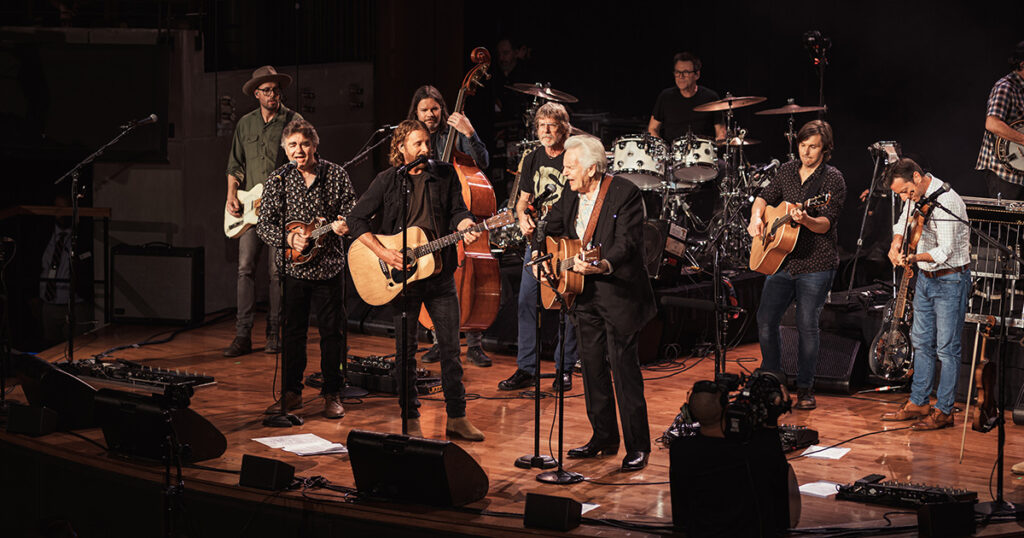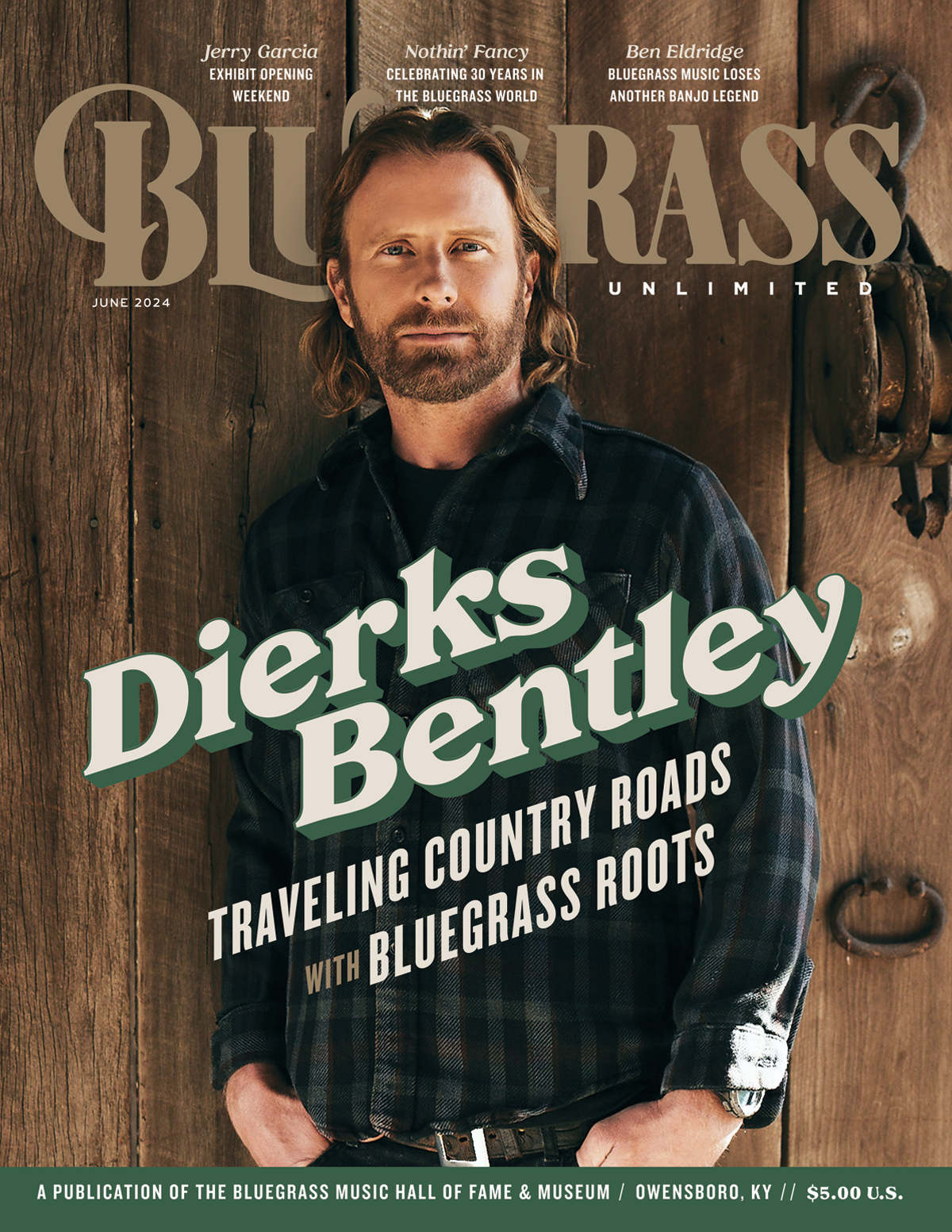Home > Articles > The Artists > Bluegrass & Bourbon
Bluegrass & Bourbon
Dierks Bentley Embraces Two Western Kentucky Traditions
Photos by Zach Belcher
Owensboro (Kentucky’s fourth largest city) is known as the culinary and cultural hub of western Kentucky due in large part to its extraordinary three B’s—Bluegrass, Bourbon and Barbecue. As the birthplace of the International Bluegrass Music Association (IBMA) and the home of the Bluegrass Music Hall of Fame and Museum and the annual ROMP festival, Owensboro can rightly claim to be the “bluegrass capital of the world.” Another great pride of Owensboro is the Green River distillery’s Kentucky straight bourbon whiskey. Green River was founded by J. W. McCulloch in 1885 and is Kentucky’s tenth oldest licensed distillery. The third B is Owensboro’s world-renowned signature hickory-smoked barbecue mutton and flavorful burgoo that is enjoyed by locals and visitors at a wide variety of locally-owned restaurants.
In June of this year, country music star Dierks Bentley will be embracing two of Owensboro’s three B’s by headlining the ROMP music festival and launching a new signature blend of bourbon at the Green River distillery. The show at ROMP will, no doubt, lean towards bluegrass. In addition to the members of his touring band—most of who are talented bluegrass pickers—Bentley will be calling up some of his long-time bluegrass friends from Nashville to help him out during the show. The new bourbon blend, expected to launch this summer, will be called Row94. Why Row94? Bentley explains, “It is 94 proof and 1994 is the year that I discovered bluegrass music.” To date, twenty-two of Bentley’s songs have risen to the number one position on the country music charts and as much as he loves country music, he states, “I am a bluegrass fan first and foremost.”
Discovering Bluegrass
Growing up in Phoenix, Arizona, Dierks Bentley was not exposed to much bluegrass music, other than what he saw watching Hee Haw. His father was a country music fan and enjoyed the music of artists like Hank Williams Sr., George Straight and Randy Travis, but when Dierks got his first electric guitar (at the age of thirteen) he was more interested in learning how to play the music of bands like AC/DC and Van Halen. He said, “I was playing anything that involved a distortion pedal and a Strat.”
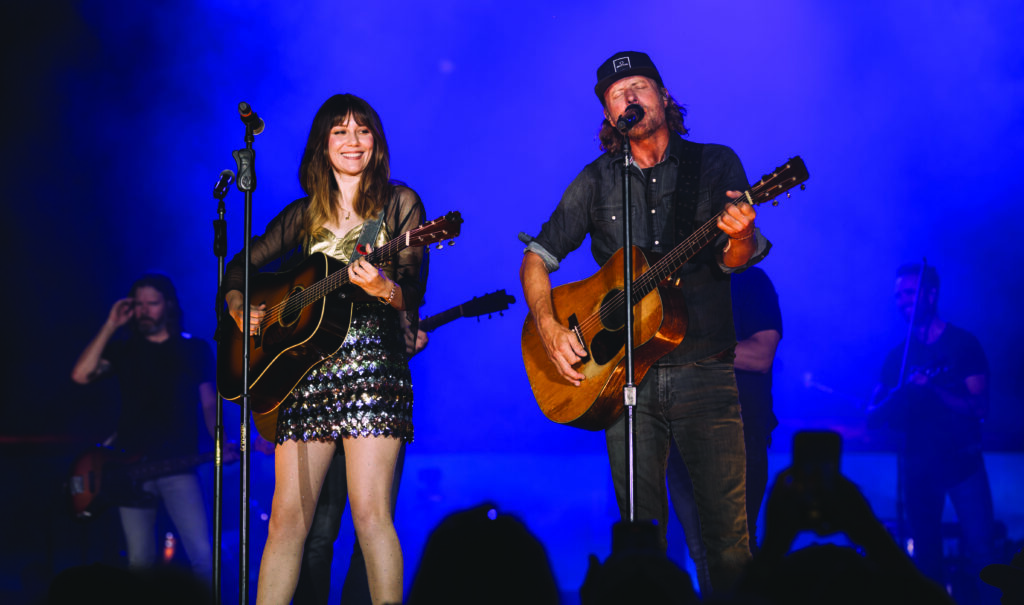
It wasn’t until he heard “Man To Man” by Hank Williams Jr., at the age of 17 that his ear was turned towards country music. Interest in Hank Jr. opened him up to exploring other contemporary country artists such as Alan Jackson, Clint Black, Dwight Yoakam, Marty Stuart and Garth Brooks. He said, “It had been my dad’s music, but after hearing Hank Jr. I started to make it my music.”
By the time Dierks was ready to go to college, his heart was set on getting to Nashville and becoming a country music singer and songwriter. After spending one year at the University of Vermont, he was able to transfer to Vanderbilt University in Nashville and pursue his dream. Although he did attend Vanderbilt for three years and earned his degree in English, he admits that the college degree was secondary to his goal of making it in country music. He said, “Technically I studied English, but I didn’t get good grades because I spent most of the time sitting in the back of the classroom writing songs.”
The first thing that Dierks did upon arriving in Nashville in 1994 was to get a job working at the Country Music Association so that he could begin to learn something about the business. The next thing was to start hanging out at the country music venues around town to familiarize himself with the music scene in Nashville. In an interview conducted by Bluegrass Unlimited in 2010, Dierks said, “I was looking to learn. I wasn’t trying to draw attention. I was as green as could be. I was trying to find someone or something just to latch on to so I could try to better myself, find my path.”
Bentley found something that he could latch onto when he went to the Station Inn and heard The Sidemen (see the sidebar on The Sidemen on page 26). At that time, The Sidemen had a weekly gig at the Station Inn every Tuesday. Although the band’s personnel changed over the years, Dierks recalls that the band at that time included Terry Eldredge, Ronnie McCoury, Jimmy Campbell, Richard Bailey, Gene Wooten and Mike Bub.
In the 2010 interview, Bentley said, “The second I walked in the door I felt like I’d been transported into a totally different part of Nashville, watching these guys onstage and seeing how much fun they were having and how young they were, it was a life-changing experience. I didn’t realize how relevant and how cool and how powerful that music was until I walked in there. It wasn’t just The Sidemen; it wasn’t just those guys; it was the whole room, the whole community, the whole vibe.”
Bentley became a fixture at the Station Inn. He also started inviting his friends from college to attend shows with him and, as a result, the venue acquired a following of college-aged fans. Mike Bub recalls, “Back then, Nashville was a dead town during the week. That was before the conventions and conferences started coming in. We didn’t have a very big crowd at the Station Inn on Tuesday nights. But then Dierks started coming every week and bringing his buddies from Vanderbilt. Then the girls started coming with them. It became a Vanderbilt scene and we began to draw a good crowd.” At first, Dierks was just a fan in the crowd. Eventually—years later—he would be invited up to sing with the band on occasion.
Ronnie McCoury remembers Dierks hanging out at the Station Inn with his college friends and says, “It was a long time before I knew he played and sang. Eventually, I saw him at some picking parties around town playing the guitar and singing and I said, ‘I had no idea you did this!’ Then he started playing at some venues downtown and he called us guys to help him out. He didn’t know much about bluegrass when he came to town, but he was smart, talented and a hard worker. He really soaked it up.”
Fiddler Jason Carter agrees with McCoury’s assessment of Bentley’s dedication to bluegrass. He said, “The Station Inn became like a second home to Dierks and he cut his teeth on bluegrass there. He worked really hard on writing, playing the guitar and singing. He studied it and he lived it.”
Carter became friends with Bentley soon after Dierks moved to town and they eventually started hanging out and writing songs together. Jason said, “He was much better at writing songs than I was and before I knew it, he had a catalog of songs that he had written. He got a writer’s deal in Nashville before he got his first record deal.”
In the 2010 interview in BU, Dierks remembers his early days at the Station Inn, “Through bluegrass I kind of rediscovered real country music, ’cause The Sidemen were playing Osborne Brothers songs. It is bluegrass or country? I don’t know. These guys were working when there wasn’t such a big gap between the two. And Terry Eldredge singing those George Jones songs, and Haggard songs, Faron Young, Ray Price. I listened to those guys, and I went back and got way into that music.”
Getting “way into that music,” wasn’t just through his exposure at the Station Inn. Bentley also was able to land a day job at The Nashville Network (TNN), archiving vintage performances. He studied and learned. He said, “I’d watch people like Little Jimmy Dickens and Stringbean on the old Grand Ole Opry shows. They were so funny and they entertained so well. They could do it all. They could play, sing and entertain. Faron Young…what a great singer he was. I became a huge Faron Young fan. I loved his voice and he could entertain with just the way he turned his head and looked at the camera. A lot of people were like that. Kenny Rogers was like that. I also loved the Johnny Cash show and T. Tommy Cutrer’s emcee work…I really enjoyed it all. It was all very interesting. You have to entertain and tell stories and that generation was the best at it.”
Regarding Dierks Bentley’s success in country music, Mike Bub said, “He really caught fire. He is a great guy and writes great songs. He has personality and stage presence. He knows how to work the crowd. I think he learned part of that watching Ed Dye at the Station Inn. Ed was a nut…like the Jonathan Winters of Nashville. He would come up on stage and introduce The Sidemen and do some comedy. I think Dierks might have taken something from that because he knows how to approach an audience. He learned that you never leave your audience out of your show.”
Going Country But Staying Connected to Bluegrass
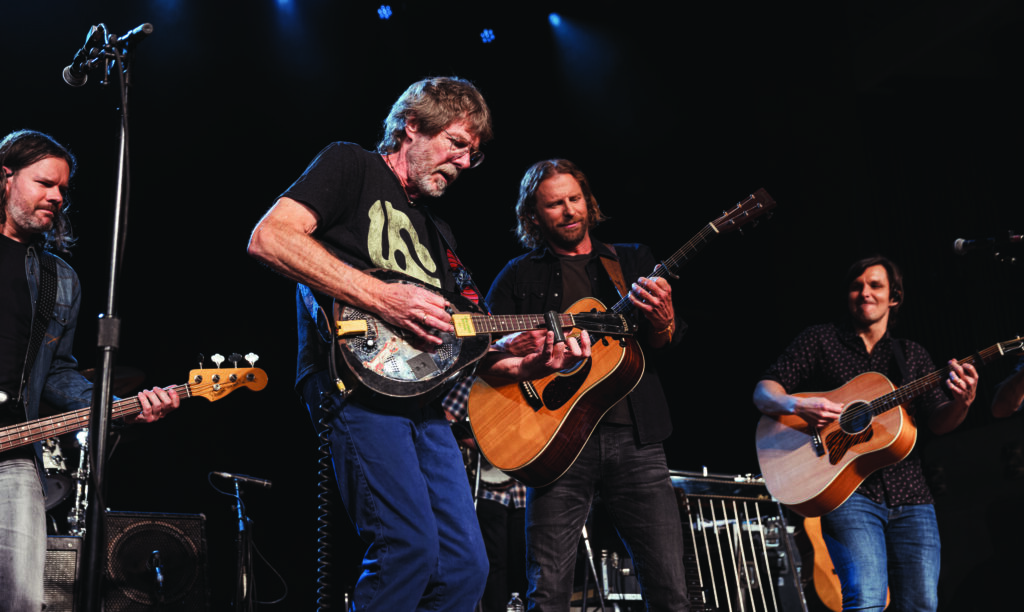
In addition to occasionally performing as a guest with The Sidemen at the Station Inn, Bentley started to get other gigs around Nashville. He performed at venues such as the Market Street Brewery on Second Avenue and at Wolfy’s on lower Broadway. Sometimes he performed solo, sometimes he would go out as a duo with his banjo-playing cousin Avery Ogden. When the gig paid well enough, he’d also bring out some of his buddies from The Sidemen. In 2001, Bentley released an independent CD and some of his friends from The Sidemen joined him on that recording. In 2003 he signed with Capitol Records. Bentley said “Nashville was a ten-year town for me. From the time I arrived to the first time I played on the Opry was almost ten years. He arrived in 1994 and after a lot of hard work was able to sign his first major label record deal in 2003.
His first release on Capitol, Dierks Bentley, was not a typical “hat-act” country record because Dierks wanted to include his bluegrass friends in the mix. He brought in Glen Duncan and Shad Cobb to play the fiddle, Randy Kohrs on resonator guitar, Terry Eldredge on background vocals and Bryan Sutton to play guitar, mandolin and banjo. Additionally, he recorded a single that was co-written by Harley Allen and brought in the Del McCoury Band to back him up on the album’s final tune, “Train Travelin’.”
Ronnie McCoury said, “Dad had met Dierks and knew him to be a good guy, so he was willing to work with him. We went into the studio and recorded “Train Travelin’” and also recorded “Good Man Like Me” for his next record (2005’s Modern Day Drifter). Dierks included bluegrass on these albums because he wanted to show that side of himself.” When the Dierks Bentley album sold a million copies, Bentley gave a platinum album to Station Inn owner J.T. Gray. He also hired The Sidemen to play his first fan club party at Fan Fair in 2003.
The McCourys and members of The Sidemen have maintained a solid connection with Bentley since that time. He has continued to include his bluegrass friends on various recording projects and after his 2010 bluegrass record Up On The Hill was released, he took the Travelin’ McCourys out with him for a sold-out 25 show tour. Ronnie McCoury said, “When Dierks had the Seven Peaks festival in Colorado, he always included us and whenever we do something where we are commemorating dad, Dierks comes if he can be there.”
In 2021 Dierks played a big show in Telluride and brought in some of his bluegrass friends. He said, “We were recording an EP called Live from Telluride and I recruited everybody, Sam Bush—the king of Telluride—Jerry Douglas…the McCourys were involved and Del came out and surprised me for a song. I still can’t believe that. Del was not supposed to be there. I had zero expectations that he was going to be there. I had put on my Del McCoury T-shirt that says ‘Del Yeah!’ under my pearl snap and I said, ‘The only guy who couldn’t make it out here tonight is Del McCoury, but we are going to have him here in spirit. I took my pearl snap shirt off and had my Del McCoury shirt on and all of the sudden Del McCoury walked out from behind me. To this day, it is the most surprised that I’ve ever been in my life. Here is Del McCoury, 82 years old, flying two planes across country and then driving an hour and a half to get to Telluride just to surprise me. It was one of the nicest things that anyone has ever done for me.”
In 2021, Bentley also recorded the tune “High Note” with the help of bluegrass friends and shot the video for the song at the Station Inn. He brought in Jerry Douglas, Bryan Sutton and Billy Strings, among others. Dierks said, “It was a really fun day in the studio with those guys. I’m a huge fan of Jerry Douglas, no one else plays like that. We did the video at the Station Inn with Sam and Billy and it was really fun. We spent a day there pretending like it was the end of the world and we were eating peaches out of a can and picking bluegrass music. Billy was right on the cusp of really blowing up. It is unbelievable how big he has gotten, but after you watch him do a live show it is not that surprising. He is so good. I’m just happy to be alive in this era and get a chance to watch what he is doing. I love it.”
Most recently, in 2023, Bentley had a standing gig at the Station Inn playing nine shows under the band name Long John. Dierks explained, “Our bus driver’s name is John Long so our band originally became John Long and the Long Johns and then it just became Long John. We played the Station Inn on the first Tuesday of the month for a while. It was a lot of fun and we brought up guests…Molly Tuttle…Ketch Secor from Old Crowe…a lot of guests came out.”
The Band
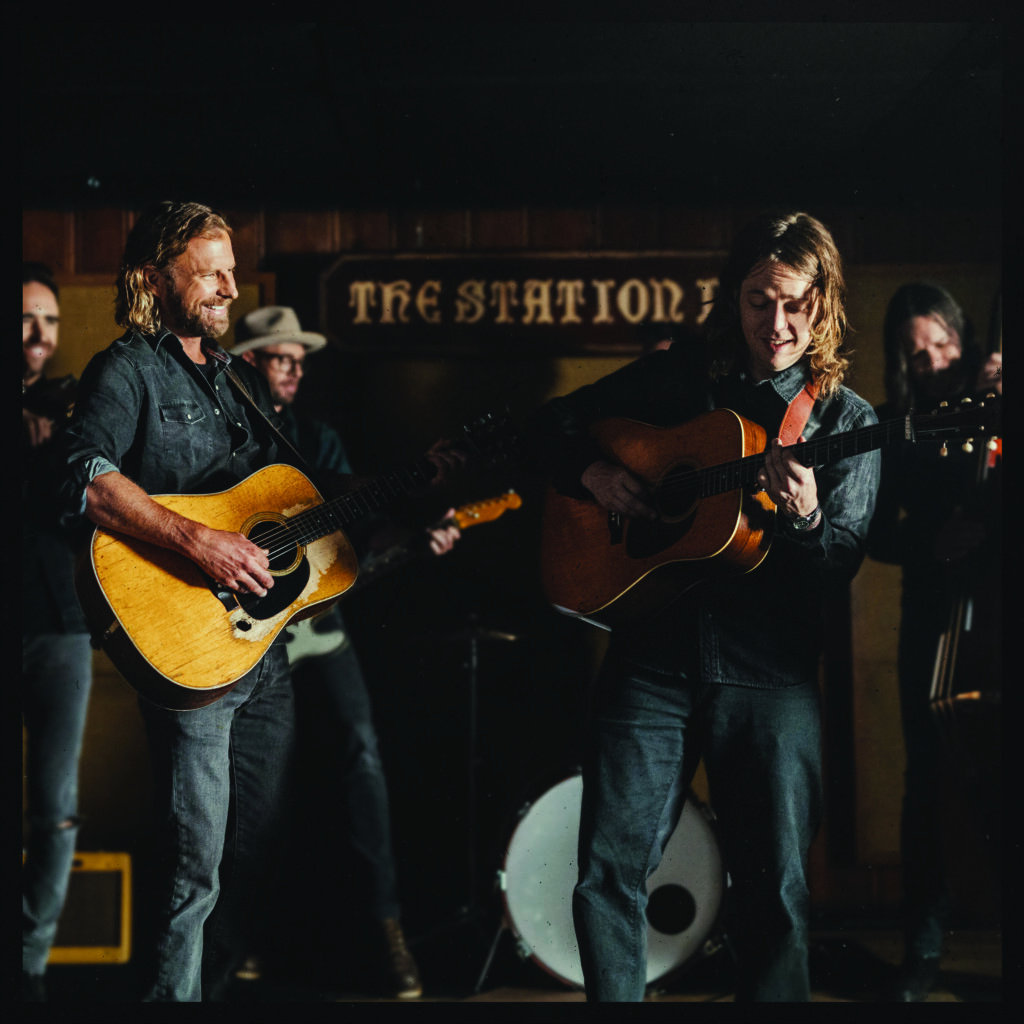
For someone who plays country music, but never steps too far away from bluegrass, you would imagine that he would select members of his band to be people who can straddle both worlds with ease, and this is indeed the case. Dierks said, “Two of my guys went through what I call the Ricky Skaggs school of country and bluegrass—the university that is playing in Ricky Skaggs’s band. If you play in that band, it is the greatest PhD program in country and bluegrass music. Ben Helson, our guitar player, played with Rhonda Vincent and Ricky Skaggs and our steel and banjo player, Tim Sergent, played with Ricky Skaggs. I have some guys in my band that are pretty good bluegrassers and the others have worked hard over the years to get better at it.”
Regarding the other band members who didn’t come from bluegrass, Dierks said, “Our upright bass player, Cassady Feasby…he did such a good job at the Station Inn. I think that is the hardest spot in the band, the upright bass player. Everyone else can kind of lay in and lay out and count on someone else to pick it up. But if the upright bass player misses one note by a fraction, everyone turns to look at them. Steve Misamore plays bluegrass snare and our fiddle player, Don Hochhalter, has won the CMA’s for fiddle player of the year and is a great fiddle player. Charlie Worsham, who is in our band now, is no slouch when it comes to bluegrass music. So we have a pretty good band when it comes to that. We have so much respect for bluegrass music and the bands that are out there that do it. We are all fans first and foremost, but we love the chance to do special events like the ROMP festival. It is a big deal and a challenge for us and it is something we approach with a lot of respect and an appreciation for the bluegrass bands out there.
ROMP 2024
Dierks Bentley will be closing Saturday evening’s show at the ROMP festival this year. When asked about his participation in this year’s festival, Dierks said, “At the ROMP festival this year, I’m looking to try and replicate a little of what we did in Telluride back in 2021. I can’t believe the line-up. You know, every year we have one show that is kind of our goal post…the show that we are rehearsing for, the one that we are anticipating. Usually it is playing the Bridgestone Arena here in Nashville. The hometown show is always the one I usually put my sights on. But this ROMP festival…the line-up is unbelievable. Molly Tuttle will be there. We had a chance to tour with her last year and her whole band is great. Her band with Kyle Tuttle and Bronwyn…the band is so entertaining to watch. Leftover Salmon will be there. Also, East Nash Grass…those guys are so good. Earls of Leicester will be there. Po’ Ramblin’ Boys…I am a huge fan, I love their music. So, I’ll be there playing but it will be like going back to the Station Inn for me. I’ll be the kid with the popcorn on the side stage watching these incredible bands and I’ll be recruiting some of them to come help me pull my set off. These are the best of the best playing that festival. I couldn’t be more thrilled and I’m feeling the pressure to put on a great show.”
Whiskey Row and Row94
In addition to working as a recording and touring musician and songwriter, Dierks Bentley owns a small chain of country bars called Whiskey Row. There is one in Nashville, two in Arizona and one in Colorado. Recently he has partnered with the Green River distillery in Owensboro, Kentucky, to produce a signature blend of bourbon whiskey. Dierks said, “I opened the first bar back in Arizona in 2012 and named it Whiskey Row in honor of Prescott, Arizona, where the western whiskey row was located. I always wanted to have my own bourbon in my bar and it has taken a long time to do that. I’ve looked at a lot of different distilleries and a lot of different ways of making it. I wanted it to be practical and affordable. I know that you can make good whiskey and it doesn’t have to cost a lot. I wanted something that was at least four years old Kentucky straight bourbon whiskey.”
After searching for a distillery that would meet his requirements, Dierks decided on Green River. He said, “I love Green River. I love that it is in Owensboro, which has the bluegrass museum there, which I’ve been to and I love. It is also the tenth oldest distillery in the state and just like an old Martin guitar it has got scars and cracks and smells and stories to tell and I just love walking the bourbon campus there. Everyone who works there are such great people. They are real bourbon people and I love their stuff. I love the Green River bourbon. It is not expensive, but it tastes great. There are a lot of guys out there promoting stuff that they don’t drink themselves and I can’t do that. I try to make it authentic to who I am. So, we are working with them to create a blend. It is going to be 94 proof to have that little kick and 94 is the year that I discovered bluegrass music. So we are calling it Row94.”
The Bluegrass Hall of Fame and Museum
When asked about his trip to visit the Bluegrass Hall of Fame and Museum while he was in Owensboro, Dierks said, “It is incredible. I love that it is such a nice, modern building and I like that it gives bluegrass the respect that it should get. Some people might think that a bluegrass museum would be kind of old and look like Cracker Barrel. No. It should be a modern building that is exciting to walk into. The displays and the technology that is being used there made me happy to see that bluegrass music is getting this kind of attention to detail and forward thinking. People that walk in there will get the feeling that bluegrass music is very current. It is respectful of the music and places it in the here and now. The people who put it together knew what they were doing. It is so well done. I can’t say enough good things about it.”
The last time that Dierks Bentley was on the cover of Bluegrass Unlimited was in 2010 when he released his album Up On The Ridge. The fact that he is a country music star and we have placed him on the cover of this magazine a couple of times may put off some hard-core bluegrass traditionalists. However, when artists of his stature pay tribute and give respect to bluegrass—because he loves it as much as any hard-core traditional fan—it is good for the music. When I talked with Ronnie McCoury about Dierks, he finished up the interview by saying, “Dierks is the greatest dude. He is salt of the earth. When I was moving into a new house he came over with his pick-up truck and helped me move. It was just him and me moving heavy furniture up the stairs. That is the type of guy he is…he will help you out. We all love him to death and he has been a great friend over the years.” So, he is a great guy who loves bluegrass music and does whatever he can to help spread the music to a wide fan base in an effort to give back to bluegrass what it has given to him…and we who love bluegrass receive the benefits. Thanks Dierks!
The Sidemen
By Dan Miller
In the music industry, in general, the supporting musicians, or “sidemen,” do not get a lot of recognition. The star out front may be very famous, but the names of those who support the star on stage will, in most cases, only be known to the most ardent fans. In the early 1990s a group of these sidemen got together and formed a band. They were together for sixteen years but did not tour much and only recorded one album. Although the band comprised some of the best bluegrass musicians on the planet, if you had never been to the Station Inn in Nashville on a Tuesday night, you may have never heard of The Sidemen.
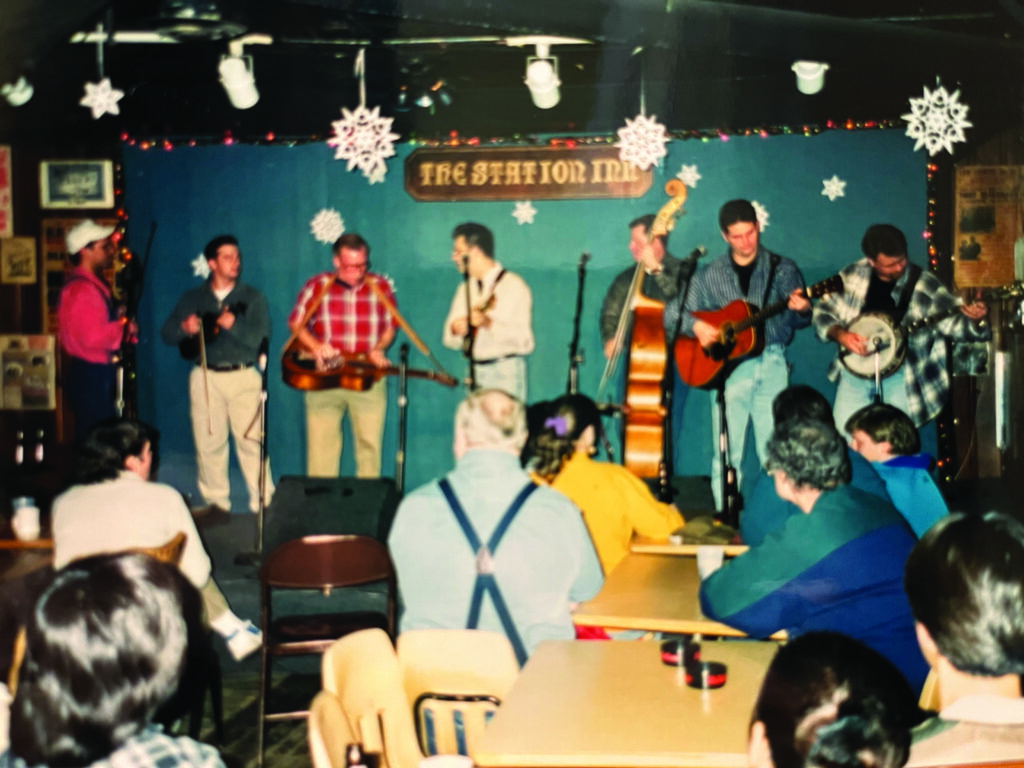
The Sidemen grew out of a jam session at Bill Monroe’s Bean Blossom festival in 1989. Five musicians who were side musicians for three of the top first-generation bluegrass bands got together to jam at the festival. At the jam Billy Rose, who was playing bass for Bill Monroe, played the banjo. Jimmy Campbell, who was playing fiddle for Jim & Jesse played the fiddle. Terry Smith, Terry Eldredge and Steve Thomas, who were all performing with the Osborne Brothers at Bean Blossom, played bass, guitar and mandolin, respectively. They enjoyed the jam so much that they decided it would be fun to get together and perform at the Station Inn when they were back home in Nashville.
In the fall of 1989 The Sidemen started performing at the Station Inn about one night per month. When Terry Smith became busy with other things, Mike Bub, who had recently arrived in Nashville, took his place. When Steve Thomas got a gig with a country artist, Mike Compton came in to take his place on mandolin. Gene Wooten also joined the band playing Dobro. In 1992, Mike Compton moved to New York. Luckily Ronnie McCoury had just moved to town and joined the band to take Mike Compton’s place. By 1992 the band had started playing at the Station Inn on a weekly basis, holding down the Tuesday night spot.
The next band member to leave was Billy Rose. Larry Perkins came in to take his spot on the banjo. At times, other side musicians around Nashville would fill in when one of the regular band members couldn’t make it — musicians like Ernie Sykes and Lester and Mike Armistead were regular fill-ins. Early on, the legendary Ed Dye was the guy who took money at the door and would introduce the band. He would also get up and sing a couple of numbers during the show, play bones and tell jokes on stage.
Mike Bub said that at first there wasn’t a big crowd at the shows because back then Nashville nightlife was fairly dead on the week nights. In 1994, when Dierks Bentley and his friends from Vanderbilt started coming, things picked up because it became a college hang out. Bub said that the college crowd continued to frequent the show until the Station Inn became smoke free. He said, “The college kids came to drink beer and smoke cigarettes. When the bar became smoke-free, they went elsewhere.”
For a number of years in the mid-1990s, The Sidemen closed the show at the annual IBMA convention. Mike Bub reports that a lot of the people who attended the convention in Owensboro, and later in Louisville, would fly out of Nashville, but stay through Tuesday so that they could catch the band there. One of those people was Toshio Watanabe from Japan. Watanabe liked the band so much that he put up the money for The Sidemen to record an album on the Japanese Red Clay label. The 1997 release led to The Sidemen touring Japan for ten days in 1998. Larry Perkins was unable to make that trip and was replaced by Rob McCoury.
By the late 1990s Jamie Johnson had moved to town and was living with Terry Eldredge. He came to the Station Inn shows and started joining the band to sing harmony parts. The band’s repertoire primarily consisted of standard bluegrass and traditional country songs. The only original music that they performed were a few instrumentals that were written by band members. Bub remembers that one of the instrumentals, written by Jimmy Campbell, was titled “Running Late” because the band typically never started the show on time.
Over the years, The Sidemen show at the Station Inn drew in many prominent politicians, musicians and actors. The U.S. Secretary of the Treasury under Bill Clinton came in for a show, which was memorable because the Secret Service came into the club on the day of the show to look over the venue. Doc Watson came one night and joined the band on stage. Bill Monroe also made an occasional appearance. One time Monroe sat right in front of Terry Eldredge’s position on stage as Eldredge sang “Muleskinner Blues” for the father of bluegrass. Bub also remembers actors Mel Gibson and George Clooney coming in to see the show.
On Tuesday nights the Station Inn was the place to be in Nashville for the bluegrass community, and many musicians would come and hang out if they weren’t on the road, often making it onto the stage as well. The show even continued on Tuesday night, September 11, 2001, when the small crowd gathered felt the support of their bluegrass family on that scary and tragic day. A portable black and white TV behind the bar showed the news even while the band played their sets.
By 2006 the band members felt like things had run their course and moved onto other things. But, for sixteen years seeing The Sidemen at the Station Inn on a Tuesday night was the thing to do in Nashville if you were a bluegrass music fan and thus the band is a big part of the history of bluegrass music.
